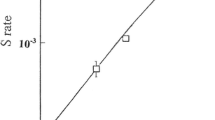Conclusions
Genetic analysis ofEscherichia coli K-12 stows that the unequal genetic contribution of the two parents to the progeny can be explained by the assumption of a highly localized disturbance in segregation, whereby a locus or small regionE of a chromosome is contributed to most of the progeny by theF — parent only. The position of this regionE, as inferred from haploid segregation data, shows a remarkable correlation with the position of the ‘eliminated segment’ which is haploid, and mostly ofF — origin, in otherwise diploid ‘heterozygotes’. In addition, segregations are disturbed "by irregular pairing, which determines apparent negative interference, and seriously biases the assessment of gene order and estimation of linkage unless taken in proper consideration. The simplest representation calls for a single linkage group, carrying in the middle the elimination locusE, and thus dividing the single chromosome into two practically independent segregation groups. Although this picture may need further refinement, as there may be more than one elimination locus or break defining the extremes of the eliminated region, it has permitted consistent mapping of the markers investigated so far.
TheHfr mating-type behaves as a locus close to, or identical with,E. The possible relationships ofE, Hfr/F + and the lambda prophage have been discussed.
Similar content being viewed by others
References
Bailey, N. T. J. (1951). The estimation of linkage in bacteria.Heredity,5, 111.
Catcheside, D. G. (1951).The genetics of microorganisms. Pitman, London, p. 187.
Cavalli, L. L. (1950). La sessnanta nei batten.Boll. Insl. sieroter. Milano,29, 281.
Cavalli, L. L. (1952). Genetic analysis of drug-resistance.Bull. World Hlth Org. 6, 185.
Cavalli, L. L., Lederberg, L. &Lederberg, E. M. (1953). An infective factor controlling sex compatibility inBacterium coli.J. Gen. Microbiol. 8, 89–103.
Cavalli-Sforza, L. L. &Jinks, J. L. (1953). Observations on the genetic and mating system of E. coli K-12.Proc. IXth Int. Genet. Gongr. (in press).
Clowes, R. C. &Rowley, D. (1954). Some observations on linkage effects in genetic recombination inE. coli K-12.J. Gen. Microbiol. 11, 250–60.
Fried, J. P. &Lederberg, J. (1952). Linkage inE. coli K-12.Genetics,37, 582.
Grigg, G. W. (1952). Back mutation assay method in micro-organisms.Nature., Lond.,169, 98.
Hayes, W. (1952a). Recombination inBact. coli K-12; uni-directional transfer of genetic material.Nature, Lond.,169, 118.
Hayes, W. (1956). Genetic recombination inBact. coli K-12; analysis of the stimulating effect of ultra violet light.Nature, Lond.,169 1017.
Hayes, W. (1953). Observations on a, transmissible agent determining sexual differen fcation inBacterium coli.J. Gen. Microbiol. 8, 72.
Jacob, E. &Wollman, E. (1954). Induction spontanée du développement du bactériophage au cones de la recombinaison génétique. chezE. coli K-12.C.R. Acad. Sci., Paris,239, 317–19.
Jinks, J. L. (1952). Competitive suppression and the determination of linkage in micro-organisms.Nature, Lond.,170, 106.
Lederberg, J. (1947). Gene recombination and linked segregation inEscherichia coli.Genetics,32, 505.
Lederberg, J. (1949). Aberrant heterozygotes inEscherichia coli.Proc. Nat. Acad. Sci., Wash.,35, 178.
Lederberg, J., Cavalli, L. L. &Ledeebeeg, E. M. (1952). Sex compatibility inEscherichia coli.Genetics,37, 720.
Lederberg, J. &Lederberg, E. M. (1952). Replica plating and indirect selection of bacterial mutants.J. Bacterial. 63, 399–406.
Lederberg, E. M. &Lederberg, J. (1953). Genetic studies of lysogenicity inEscherichia coli.Genetics,38, 51.
Lederberg, J., Lederberg, E. M., Zinder, N. D. &Lively, E. R. (1951). Recombination analysis of bacterial heredity.Cold Spr. Barb. Syrup. Quant. Biol. 16, 413.
Lederberg, J. &Tatum, E. L. (1946). Gene recombination inEscherichia coli.Nature, Lond.,158, 558.
Nelson, T. C. &Lederberg, J. (1954). Postzygotic elimination of genetic factors inEscherichia coli.Proc. Nat. Acad. Sci., Wash.,40, 415–19.
Newcombe, H. B. &Nyholm, M. H. (1950). Anomalous segregations in crosses ofEscherichia coli.Amer. Nat. 84, 457.
Rothfels, K. H. (1952). Gene linearity and negative interference in crosses ofEscherichia coli.Genetics,37, 297.
Watson, J. D. &Hayes, W. (1953). Genetic exchange inEscherichia coli K-12; evidence for three linkage groups.Proc. Nat. Acad. Sci., Wash.,39, 416.
Wollman, E. L. (1953). Sur le détermirdsme génétrque de la lysogénie.Ann. Inst. Pasteur,84, 281–93.
Wollman, L. L. &Jacob, E. (1954). Lysogénie et recombinaison génétique chezE. coli K-12.G.R. Acad. Sci., Paris,239, 455.
Zinder, N. D. &Lederberg, J. (1952). Genetic exchange inSalmonella.J. Bact. 64, 679.
Author information
Authors and Affiliations
Rights and permissions
About this article
Cite this article
Cavalli-Sforza, L.L., Jinks, J.L. Studies on the genetic system ofEscherichia colt K-12. J Genet 54, 87–112 (1956). https://doi.org/10.1007/BF02981705
Received:
Issue Date:
DOI: https://doi.org/10.1007/BF02981705




